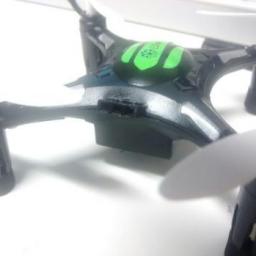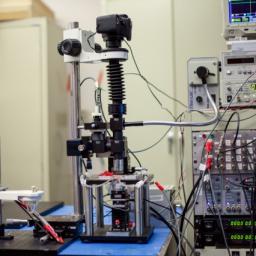
Since now you're going to either
register your drone or have to be flying your indoors anyway in the USA, you might as well celebrate the one freedom you still have the freedom to re-flash the firmware with open source! The Eachine H8 is a typical-looking mini-quadcopter of the kind that sell for under $20. Inside, the whole show is powered by an ARM Cortex-M3 processor, with the programming pins easily visible. Who could resist? Garagedrone takes you through
a step-by-step guide to re-flashing the device with a custom firmware to enable acrobatic mode, or simply to tweak the throttle-to-gyro mapping for the quad. The firmware author silverxxx from RCGroups.com even got the
code up on GitHub if you're interested in taking a peek. Next step, Skynet!
In defiance of the rage of the security community who see the advances of spyware and intrusiveness endangering our precious private lives and anonymity Samsung have mated a mobile phone and a fridge to produce a device
dedicated to supplying food and spying on you. Samsung showed models of this impressive privacy intruding device at the recent CES demonstrating how the 'Tizen' software could add a whole new dimension to invading our privacy in our own homes. Mike Lilly from Samsung Electronics Australia was quoted as saying this was "meaningful innovation" adding "We've seen internet fridges out there in the past but this is actually useful", meaning that it is useful for recording information about eating and spending habits to a degree higher than currently available even compared to mobile phone apps. Samsung plan launch the fridge in July quoting "it's important to get it into a lot of homes". Scary.

State-of-the-art atomic force microscopes (AFMs) are designed to capture images of structures as small as a fraction of a nanometer - a million times smaller than the width of a human hair. Atomic force microscopes typically scan samples using an ultrafine probe, or needle, that skims along the surface of a sample, tracing its topography, similarly to how a blind person reads Braille.
http://news.mit.edu/2015/new-microscope-real-time-videos-nanoscale-1214 Since now you're going to either register your drone or have to be flying your indoors anyway in the USA, you might as well celebrate the one freedom you still have the freedom to re-flash the firmware with open source! The Eachine H8 is a typical-looking mini-quadcopter of the kind that sell for under $20. Inside, the whole show is powered by an ARM Cortex-M3 processor, with the programming pins easily visible. Who could resist? Garagedrone takes you through a step-by-step guide to re-flashing the device with a custom firmware to enable acrobatic mode, or simply to tweak the throttle-to-gyro mapping for the quad. The firmware author silverxxx from RCGroups.com even got the code up on GitHub if you're interested in taking a peek. Next step, Skynet!
Since now you're going to either register your drone or have to be flying your indoors anyway in the USA, you might as well celebrate the one freedom you still have the freedom to re-flash the firmware with open source! The Eachine H8 is a typical-looking mini-quadcopter of the kind that sell for under $20. Inside, the whole show is powered by an ARM Cortex-M3 processor, with the programming pins easily visible. Who could resist? Garagedrone takes you through a step-by-step guide to re-flashing the device with a custom firmware to enable acrobatic mode, or simply to tweak the throttle-to-gyro mapping for the quad. The firmware author silverxxx from RCGroups.com even got the code up on GitHub if you're interested in taking a peek. Next step, Skynet!